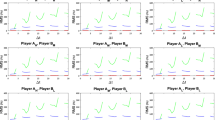Abstract
Employing stochastic programming, we provide a general framework for option pricing based on marginal bid/ask price valuation. It is applied to numerical analysis of options with European and American style exercise using a double binary tree. Incentive options are valued considering hedging restrictions and other market frictions, such as transaction and short position costs, and different borrowing and lending rates. The framework also includes correlated labor income. The possibility of partial sales is analyzed using ask price functions. Without friction costs and labor income, our model is the discrete-time equivalent of Ingersoll (J Bus 79:453–487, 2006). When labor income and/or market frictions are present, or a fraction of options is sold, the option values are materially different compared to Ingersoll (J Bus 79:453–487, 2006).
Similar content being viewed by others
References
Bettis JC, Bizjak JM, Lemmon ML (2005) Exercise behavior, valuation and the incentive effects of employee stock options. J Financ Econ 76: 445–470
Broadie M, Detemple J (2004) Option pricing: Valuation models and applications. Manag Sci 50: 1145–1177
Campbell JY, Viceira LM (2002) Strategic asset allocation: Portfolio choice for long-term investors. Oxford University Press, NY
Carpenter JN (1998) The exercise and valuation of executive stock options. J Financ Econ 48: 127–158
Detemple J, Sundaresan S (1999) Nontraded asset valuation with portfolio constraints: a binomial approach. Rev Financ Stud 12: 835–872
Fourer R, Gay DM, Kernighan BW (2003) AMPL, A Modeling Language for Mathematical Programming. Nelson Thomson Learning, Toronto
Hall BJ, Murphy KJ (2002) Stock options for undiversified executives. J Account Econ 33: 3–42
Henderson V (2005) Explicit solutions to an optimal portfolio choice problem with stochastic income. J Econ Dyn Control 29: 1237–1266
Ikäheimo S, Kuosa N, Puttonen V (2006) The true and fair view of executive stock option valuation. Eur Account Rev 15: 351–366
Ingersoll JE (2006) The subjective and objective evaluation of incentive stock options. J Bus 79: 453–487
Kahl M, Liu J, Longstaff FA (2003) Paper millionaires: how valuable is stock to a stockholder who is restricted from selling it?. J Financ Econ 67: 385–410
Koo HK (1998) Consumption and portfolio selection with labor income: a continuous time approach. Math Finance 8: 49–65
Leone AJ, Wu JS, Zimmermann JL (2006) Asymmetric sensitivity of CEO cash compensation to stock returns. J Account Econ 42: 167–192
Merton RC (1971) Optimum consumption and portfolio rules in a continuous time model. J Econ Theory 3: 373–413
Munk C (2000) Optimal consumption/ investment policies with undiversifiable income risk and liquidity constraints. J Econ Dyn Control 24: 1315–1343
Pratt JW (1964) Risk aversion in the small and in the large. Econometrica 32: 122–136
Wets R, Ziemba W (1999) Stochastic programming. State of the art, 1998. Ann Oper Res 85
Author information
Authors and Affiliations
Corresponding author
Electronic supplementary material
Rights and permissions
About this article
Cite this article
Kallio, M., Pirjetä, A. Computational methods for incentive option valuation. Comput Manag Sci 6, 209–231 (2009). https://doi.org/10.1007/s10287-008-0085-0
Published:
Issue Date:
DOI: https://doi.org/10.1007/s10287-008-0085-0




